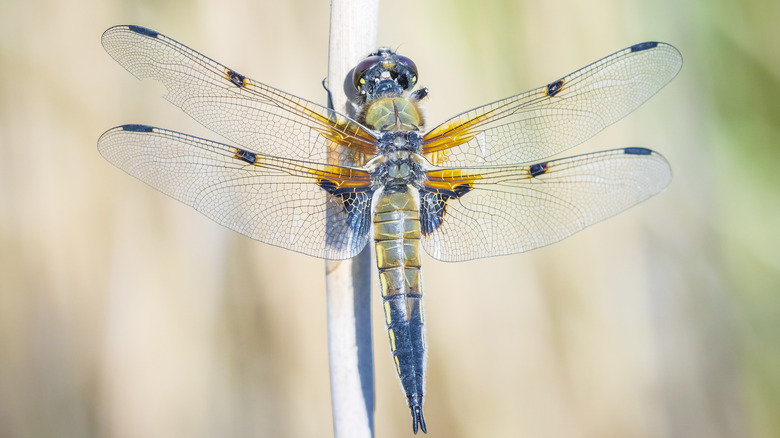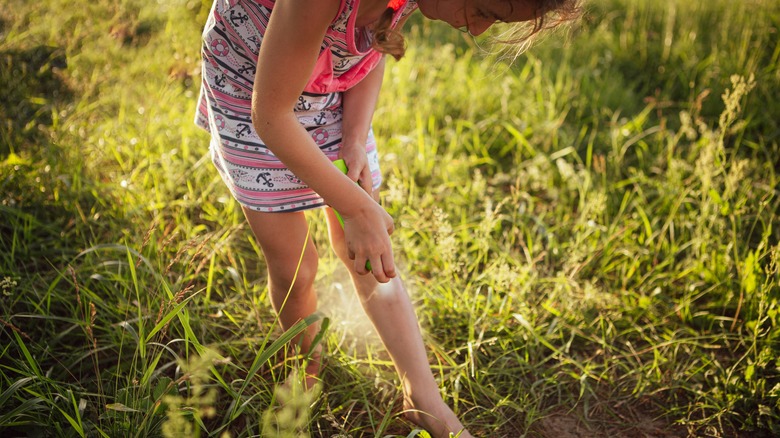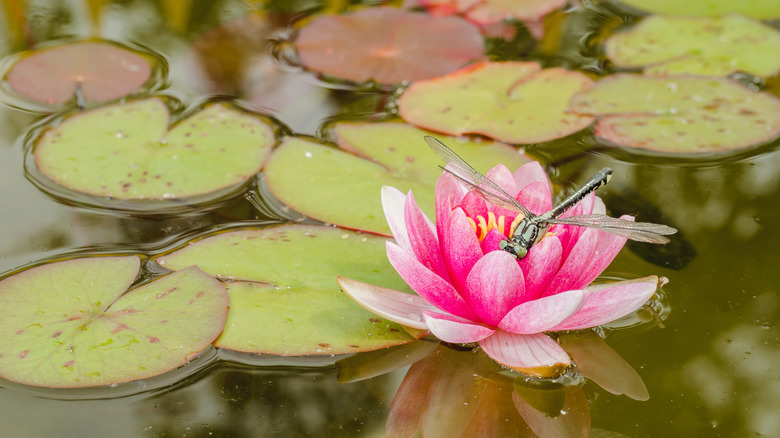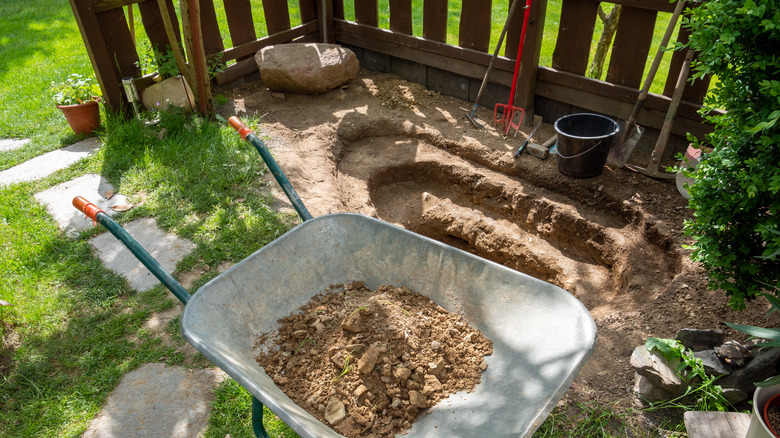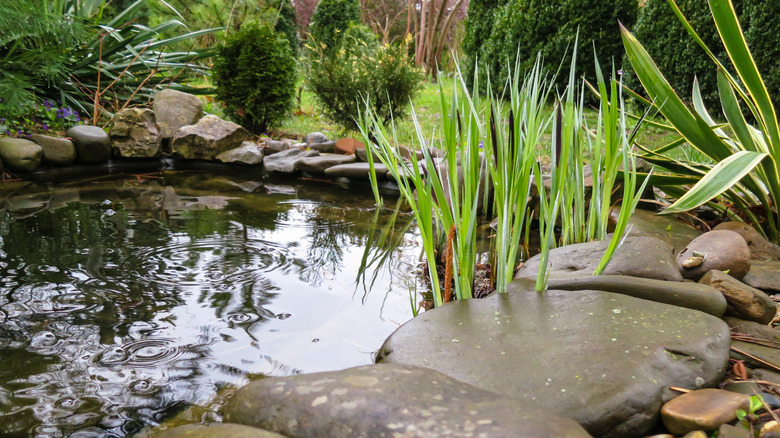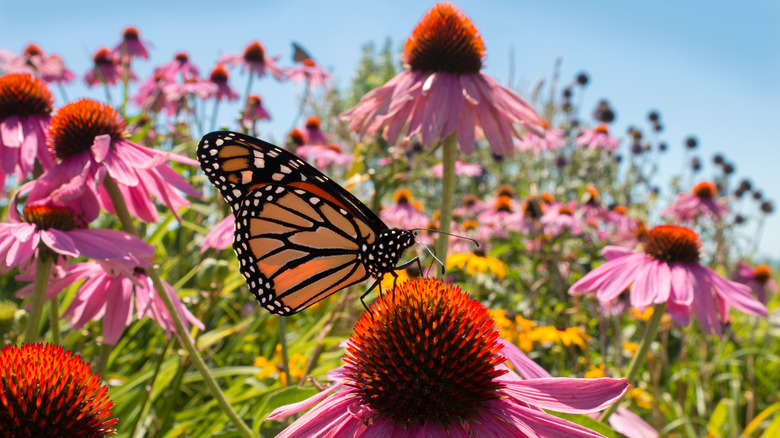How To Turn Your Garden Into A Dragonfly Habitat
The beauty of dragonflies — nature's shimmering predatory fliers — cannot be overstated as they zip through the air throughout spring and summer catching sunlight on their wings. For some, dragonflies hold spiritual meaning as symbols of transformation and new beginnings. So, if you've always found yourself captivated by these beguiling insects (and maybe have some adorable décor and artwork displayed throughout your home in honor of them), then this article is for you. Because dragonflies require access to water, creating a dragonfly-friendly habitat in your yard offers an opportunity to incorporate a zen-like water feature where you can relax the day away. And by doing so, you'll get to experience the dazzling exploits of the dragonfly up close and in person.
Dragonflies have been practicing aerial acrobatics since before dinosaurs walked the earth, and they continue to bring an element of dancing delight to the garden. Together with the very similar-looking (though smaller) damselflies, dragonflies represent an essential part of the lifecycle of a healthy ecosystem. For the purposes of this article, we will refer to dragonflies throughout but know that these techniques will bring both dragonflies and damselflies to your yard.
Dragonfly habitats are practical and functional
Perhaps one of the most convincing reasons to turn your backyard into a dragonfly habitat is the fact that these carnivorous predatory insects feed primarily on mosquitoes — up to 90% of their diet can come from that single source of food. That's great news for anyone who likes to cook, relax, or entertain in the backyard during the warm months of summer. Forget making DIY bug repellent or lining your walkways with citronella candles, and let some of nature's best hunters do the work of getting rid of dangerous bugs instead. Larvae dragonflies feed on larvae mosquitos, while adult predators eat adult mosquitoes; some have been known to eat 100 mosquitoes each in a day.
Once your habitat is established, you will be able to get rid of electric bug zappers and instead focus on designing an inviting environment. You'll soon find that your backyard has become an oasis for happy wildlife and a thriving and biologically diversified ecosystem, and you can rest assured that you've taken a positive step toward preserving a much-needed resource for both the flora and fauna of your neighborhood.
What do dragonflies need?
Above all, a clean water feature is absolutely necessary because dragonflies breed underwater. Females lay eggs in standing water where the larvae hatch and live submerged for up to a year. As they swim around the water, the little aquatic hunters prey on mosquito larvae. Something simple like a water bowl, rain barrel, or bird bath could do the trick, but a backyard pond is really the perfect water source for dragonflies. For your own benefit as well, just imagine how much inner peace a koi pond could help you find as you indulge in your chill atmosphere.
You may be thinking that bringing in a water feature will inevitably translate to even more mosquitoes, and you're not wrong. In addition to the pond, you may want to utilize Mosquito Dunks, small circular larvicide products that float on top of the water. Each one is effective over 100 square feet of water surface, which is equivalent to a 10-foot by 10-foot pond. Mosquito Dunks are made from a specific biological pesticide called bacillus thuringiensis israelensis, or Bti, that targets mosquito larvae yet is safe for humans, pets, fish, and wildlife (via the National Pesticide Information Center).
How to install a backyard pond
A simple pond structure can be built as a weekend DIY project. The basic tools required will be shovels and rakes to dig and move dirt, a pond liner, and a simple pump and filtration system to aerate the water and keep it clean. You'll also want a wheelbarrow to haul away excess dirt that can likely be reused elsewhere in your landscape. Before starting any project that involves digging, make use of the national call-before-you-dig hotline by dialing 8-1-1. Also get in touch with your local zoning commission to find out if you need a permit or a fenced yard in order to install a pond. Once you know you're cleared to dig, use a small shovel to create the perimeter; once that's set, go ahead and get down to the serious digging. If you're undecided on the best shape, use something like rope or your garden hose as a makeshift border that you can adjust and play around with.
The depth of your pond will depend on where you live because it will need to be deep enough to ensure that the deepest water will not freeze in winter. For heavily chlorinated municipal tap water, let the pond sit for a day or two after being filled and before you add any vegetation. If you have questions regarding chemical treatments and water maintenance, you'll probably get the most comprehensive answers from the staff at an aquatics and fish store.
Surround your pond with vegetation
Before your pond is complete, it'll need rocks to secure the pond liner in place and to act as warm surfaces where dragonflies can take a load off and catch some rays. Logs will be welcomed and used by the fliers and perhaps by some visiting frogs and turtles, too.
With your pond up and running, you can bet that the glistening aerialists will soon follow; before you know it, it'll be time to house and feed your hungry and actively breeding inhabitants. Surround the edges of your pond with plants that attract dragonflies, specifically those that can tolerate and even thrive in standing water. From cattails and water lilies to swamp lilies and Japanese primrose, there is a wide range of options to choose from. Most importantly, remember that diversity is key because you want to offer dragonflies both food and shelter. The Xerces Society recommends covering as much as 50% to 75% of the pond's surface with vegetation.
Incorporate tall grasses and emergent blooming flowers, then consider plants that live completely submerged. Varieties like hornwort and fanwort are hard workers that will reduce carbon dioxide and heavy metal levels in the water while simultaneously increasing oxygen throughout. Anytime you are unsure about whether a specific plant is a good fit for your region, contact your county's gardening extension experts at a nearby university or visit the local nursery for guidance on native and non-invasive species.
Increase the food source with pollinator plants
The hard truth in the grand circle of life is that dragonflies feed on more than just pesky insects. They also like to dine on bees and some butterflies. By simultaneously creating a pollinator-friendly garden away from the pond or other water feature, you will encourage the full cycle required by nature. When it comes to the best plants for your pollinator garden, think native and low maintenance. A combination of milkweed, coneflowers, and marigolds is a good start. From there you can branch out to any flowers you find beautiful. Remember, too, that bees are big on dandelions. Really anytime you're cultivating wildflowers, you'll have to embrace a certain level of natural chaos and move a manicured lawn lower down on your list of backyard priorities.
Of course, another delightful addition is a hummingbird feeder to attract the tiny gorgeous birds who are always seeking sweet nectar in order to keep their wings fluttering at more than 50 beats per second. Whatever you add to your backyard environment to encourage and support wildlife, you can expect hours upon hours of enjoyment watching their antics play out from a window inside the house or a comfortable bench positioned right next to your new pond. Enjoy the show!
